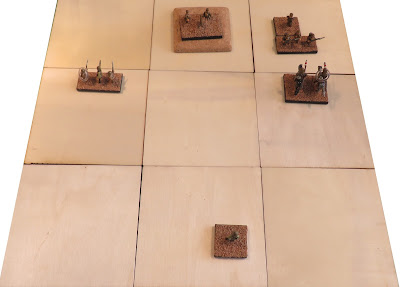The first engagement of the war was more of a skirmish than a full-scale battle. The Stalbanians – who deployed two infantry units and a machine gun unit – occupied a position that had a hill as its centre, and the Khakistanis – whose force comprised a cavalry unit and two infantry units – advanced to meet them.
All the units were rated as ‘Average’.
Please click on the image to enlarge it.
Battle Turn 1
As the Khakistanis were the attackers during the first turn, they advanced on both flanks.
Please click on the image to enlarge it.
As a result of the Close Combats that took place, the Khakistani cavalry lost 1 SP and the Stalbanian and Khakistani infantry both lost 1 SP.
The Stalbanians fought back, and their machinegun unit hit the the Khakistani infantry in the centre and caused them to lose 1 SP. The General who was accompanying them was not killed or injured.
Please click on the image to enlarge it.
Battle Turn 2
The two sides threw a D6 die to determine which would have the initiative this turn, and the Stalbanians won.
Their machine gun unit fired for a second time at the Khakistani infantry in the centre and hit them again. The infantry unit was destroyed, but the General who was with them escaped death or injury for a second time.
The Close Combats between the other Stalbanian units and their Khakistani opponents were inconclusive ... however, when it was the Khakistani turn to activate their units, the infantry unit on the Khakistani left flank annihilated their Stalbanian opponents, thus breaking through the Stalbanian position ...
Please click on the image to enlarge it.
... and winning the engagement.
Please click on the image to enlarge it.
This victory was, however, costly. The Khakistanis lost a total of 4 SPs and the Stalbanians lost 2 SPs.
This marginal Khakistani victory had an immediate effect on the campaign.
Although they were not in the Battle box, the Khakistanis immediately moved to the end of the green arrow that runs away from the Battle box.
Please click on the map to enlarge it.
Turn 4
Both sides threw a D6 die. The Khakistanis threw a 2, which took them to the 'Enthusiastic support at home' box and then up the blue arrow. The Stalbanians threw a 3, which took them to the 'Supplies are low' box and then down the red arrow.
Please click on the map to enlarge it.
Turn 5
Both sides threw a D6 die. The Khakistanis threw a 6, which took them to the next Battle box. The Stalbanians threw a 1, which took them to the 'Stolen a march on the enemy' box ... but as another battle had to be fought (this time with the Khakistanis in defence for the first turn), this had no effect on the tactical situation.
Please click on the map to enlarge it.


























.jpeg)














The 3x3 game looks like it worked very well as part of your campaign Bob
ReplyDeleteMaudlin Jack Tar,
DeleteIt worked well, but I think that it would have worked better with 6 units per side. A lesson learned for my next mini-campaign.
All the best,
Bob
Interesting. I ran into that two. Three units gives no tactical options once the battle begins. For me, four units is still to limited. 5-7 units per side seems to work best. I'm testing a random scenario generator to handle flank marches, ambushes, stragglers and reinforcements, and will do a post with it and in play examples of each.
ReplyDeleteMark Cordone,
DeleteIf I was starting out from scratch, I’d be sticking to the 6 units + a General per side for all the battles, but I might give units 1, 2, or 3 SPs each and/or rate units as Poor for the first battle, Average for the second battle, and Elite for the third battle. It’s something for me to think about.
I look forward to seeing your new ideas in action. They sound as if they will add lots of additional options to the existing concept.
All the best,
Bob
For Horse & Musket I was thinking of 3SP for Infantry units
DeleteMaudlin Jack Tar,
DeleteIt is something that I am thinking about. I am also considering using the SP values from the original PW rules (e.g. infantry = 4 SPs; cavalry = 3 SPs etc.) although this would extend the number of moves each battle would last.
All the best,
Bob
Bob,
ReplyDeleteI suppose there is no reason why the size of each 'unit' and so the area represented by each square could not vary from one game to another, provided one kept careful note of exactly what had been lost so that the number of larger units/SPs in a subsequent game could be reduced appropriately.
In the periods I game, where most troops remain in close order, I would use several bases to represent one unit if only a few were present for an engagement so that the squares didn't look too empty.
Best wishes,
Arthur
Arthur1815 (Arthur),
DeleteThere is nothing along the ‘1 unit equals …’ lines in the rules so that one can decide what is appropriate for the battle one wants to fight. In my mini-campaign, I regard a unit as being equivalent in firepower to an infantry battalion, but in some of the other games I’ve seen, each unit represents a company or platoon.
I agree about the ‘empty battlefield’. I think that using several bases to represent a unit does make the 3 x 3 battlefield look better, and it is something that I want to examine in greater detail … if and when time allows.
All the best,
Bob
I now "get" the snakes and ladders campaign thing ;)
ReplyDeleteLike it :)
Geordie an Exiled FoG,
DeleteI think that you have to try one (or see it in action) before its full usefulness becomes apparent.
All the best,
Bob